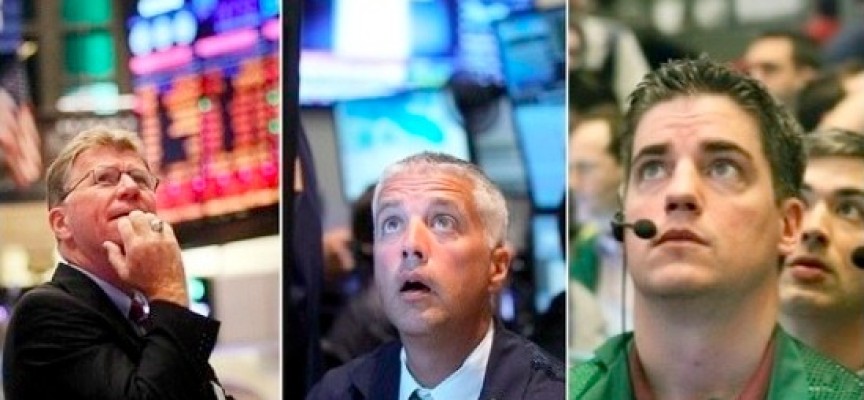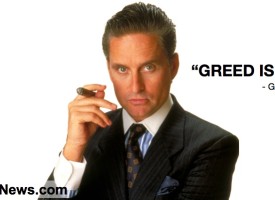What is happening with banks is about to ripple through financial markets all over the world.
April 29 (King World News) – Alasdair Macleod out of London: As well as financing escalating government deficits, central banks face an additional problem of replacing contracting bank credit to the non-financial private sector if a slump is to be avoided. The problem comes at the worst possible time in the bank credit cycle, with commercial banks’ balance sheets as highly leveraged as they have ever been.
Banks are already reducing their credit allocations to the non-financial private sector. Yet, as this article points out, it is virtually impossible for central banks to persuade commercial banks to increase their financing of genuine production. This is because they must protect themselves from increasing bankruptcies as pandemic-related support is withdrawn at a time of maximum balance sheet gearing.
The withdrawal of bank credit when post-lockdown consumer demand is unleashed will hamper the production and supply of goods to consumers, driving up high street prices which are already subject to rising commodity prices and other costs. Further monetary inflation will only make the problem worse as the purchasing power of fiat currencies is undermined. But for central banks and governments expanding the quantity of money is the only recourse they have left if they are to defer a full-scale slump.
Introduction
Everywhere, the story is of a sharp economic recovery following the end of lockdowns. The tide of unspent stimulus is expected to flood all major western economies when normal business resumes.
Furthermore, governments and central banks are going to continue stimulating us back towards economic health. The most extreme version is President Biden’s plans, involving a $1.9 trillion covid relief plan, a $1.8 trillion American Families Plan and a further $2.3 trillion infrastructure plan so far. That’s $6 trillion additional spending to normal mandated spending of about $4 trillion annually on a tax base of only $3.5 trillion. Biden says he will tax the rich to pay for some of it. That has never raised much additional revenue in the past, so it is reasonable to assume it will be all borrowed — nearly all involving inflated dollars.
Other advanced economies are following a similar, if less egregious path. Measuring it all will be GDP, certain to rise substantially later this year. “Growth” will be back. This column has frequently warned readers not to be misled by GDP, which is simply a money total. With all the monetary stimulus everywhere, money totals will obviously increase substantially, rendering the term “growth” in the true economic sense meaningless. If GDP had been invented in the 1920s, the European bloc comprising Germany, Austria, Hungary and Poland would have demonstrated spectacular growth, and a contemporary CPI would have seen “real GDP” more than doubling — even quadrupling or more. A post-WW1 economic miracle would be declared, though the reality was sadly very different…
ALERT:
Legendary investors are buying share of a company very few people know about. To find out which company CLICK HERE OR ON THE IMAGE BELOW.
 Sponsored
Sponsored
That’s the problem with macroeconomics and its statistics. It’s a non-science, which in GDP describes an evenly rotating economy, confusing an economy which is assumed to be unchanging with a dynamic one that advances the human condition. GDP matters to governments because it quantifies their revenue base, which justifies its statist popularity, but it is useless for independent forecasters. Instead, a rationalist approach to economics, understanding that economic laws exist and that they are aprioristic, is the only way to understand the current condition and the dangers from total inflationism.
The analysis spewing out of investment banks and investment management operations, being entirely macroeconomic, is flawed for these and other reasons and must be ignored in the diligent search for economic and monetary outcomes. It deflects from the real problems: the underlying factors which determine life after the lockdowns end, and the role of banks supplying credit.
Life after lockdowns
When lockdowns end, we can expect those who have accumulated unspent funds will be likely to reduce their cash balances to their more customary levels. But the ending of lockdowns is not a black and white issue. Some countries and regions will emerge later. Others, notably India, are still seeing tragic surges in covid-19. Others in the underdeveloped world are unreported. Many countries are likely to have new travel restrictions imposed upon them, and there is no guarantee that countries that have been slow to roll out vaccinations will not see new waves of new variants.
We also know that individuals whose bank balances have increased in lockdowns are predominantly members of the middle classes, the cohort which has access to mortgage and consumer finance. And it is its members who are buying houses in the country, building extensions, buying yachts and recreational vehicles. They are the target for advertisers, and the mainstay of the mainstream media. With this readership informing it, the MSM trumpets the recovery prospects. Ignored are the low paid, dependent on government support, having either lost their jobs or likely to do so as the pandemic drags on. Before the pandemic, it was frequently reported that some 70% of Americans and Brits on salaries lived from paycheck to paycheck, representing a threatening black hole for the post-lockdown economy.
With supply chains still in chaos, it is unlikely that goods and to a lesser extent services will be able to supply the predicted unleashed demand. Today, motor manufacturers are being forced to suspend production due to microchip shortages. Manufacturers of all goods and assemblers of components are similarly threatened with supply dislocations. Containers are wrongly positioned to deal with any surge in consumer demand and some industry experts think global logistics won’t be sorted out before the year end.
Prices in the high street are already rising more rapidly than before.
Probably the most important issue dismissed by macro economists is the state of the bank credit cycle, which combined with increased trade tariffs against China rhymes with the global economy when it faced similar conditions to those that collapsed Wall Street between 1929-1932. More recently, the US banking system visibly ran out of balance sheet space in September 2019, signalled by a crisis in the repo market. Shortly afterwards from February 2020, liquidity constraints crashed the US stock market, echoing the September-October 1929 phase ninety years before. Figure 1 shows that cycle compared with today, the difference being that in the earlier cycle prices were in gold through the dollar at $20.67 to the ounce, while today’s dollars are pure fiat.
Ninety years ago, the fiat excesses of bank credit expansion coupled with tariffs increased by the Smoot-Hawley Tariff Act ended up collapsing prices of everything from stocks to commodities. It was that experience that led a raft of economists to conclude that it was the collapse in prices that was the problem, ignoring the obvious fact that it was the consequence of earlier credit excesses coupled with trade tariffs. The subsequent developments of statistics, mathematical economics and macroeconomics in the pre-war years then led to a process of demonetisation of gold to be replaced with pure fiat state-issued currencies.
The monthly addition of $120bn of inflationary QE announced on 20 March 2020 accounts for and explains why the Dow index resumed its rise instead of continuing to follow the 1929-32 pattern. QE is an injection of cash into pension funds and insurance funds, to be spent on risky assets, mostly higher yielding corporate debt and equities.
This is a deliberate central bank policy in the belief that a rising stock market bolsters economic confidence, while dismissing the long run consequences. While it has worked so far and has encouraged a continuing bullish outlook, it conceals the underlying situation of a dangerously overvalued stock market at a time when the economic outlook is deteriorating.
The fiat bubble is not just restricted to the stock markets. Figure 2 illustrates how a range of prices for different assets have risen since the widespread sell-off into March 2020, when the Fed reduced its fund rate to zero and announced QE of $120bn every month. Prior to that event, prices of all these assets, other than currencies, had fallen.
Since then, cryptocurrencies have performed spectacularly, followed by commodities and equities. The new version of M2 money supply (M2SL) has increased by 22.8%, sparking far larger price rises in those three former categories, while the dollar lost 11% on its trade weighted index against other currencies.
We can see that if we are entering a contractionary stage of the bank credit cycle, then any economic recovery will be statistical and not real, because the capital will not be available to finance the pick-up in production. Taking into account the three factors of a narrow base of professional classes drawing down accumulated bank balances, supply chain disruption, and the effects of price inflation on commodities and other costs, economic outcomes may look different from ninety years ago, but the only true difference will be in the money.
Bank credit is indeed contracting
Conventionally, there are two sources of increased money supply, central bank originated money and bank credit. Historically, the quantity of broad money, which includes the deposit side of bank credit, has been about ten times central bank base money. Following the Lehman failure, when central banks expanded their balance sheets through quantitative easing, this relationship changed due to the excess reserves created. Today in the US the ratio is down to less than four times and still falling.
Following Lehman’s failure, which marked the beginning of the last downturn in the bank credit cycle, bank credit initially rose but then fell into 2010 as the economy took a hit and outstanding bank lending to the non-financial sector contracted by $731bn, or 10.5%. An initial rise can be explained by a banker’s first reaction to an unexpected crisis, which is to believe it will quickly pass, while immediate demands for credit increase due to the shock and should be supported.
This time, bank credit and lending to the non-financial sector initially rose as it did in 2009, but since then, it has declined by a little over $500bn as shown in Figure 3.
The scale of bank lending is larger than it was fallowing the Lehman crisis by 64%, and the scale of economic problems in the non-financial economy are far greater today. Thus, compared with the past and even without a banking crisis, the withdrawal of bank credit from the productive economy appears to have only just started and has much further to go. We must be forewarned that a combination of increased inflationary financing and state guarantees, inevitably supporting mainly zombie corporations, will have to be accelerated to compensate for the tendency of bank credit to continue to contract and if a debt-deflation slump is to be avoided.
Instead of lending money to risky non-financial customers, in the last year bank balance sheets have been increasingly redeployed into low-risk government and agency debt. This is most notable in the large banks, for which only 61% of their balance sheets are now exposed to non-financials, which compares with 71% in October 2010 at the height of the post-crisis recession. The phrase used for this condition in the 1970s was that the economy was being “crowded out”, with business investment and economic recovery hampered by the monetary demands of government. This time it is government plus a speculating, highly effervescent financial sector doing the crowding out.
Similarly, we find that bank credit in the UK is slowing. This is shown in Figure 4. The UK economy shares many of the US’s Anglo-Saxon traits and some of its regulatory features. The relative size of the UK’s inflationary support for its economy during the pandemic has been less than that of the US. But with an average balance sheet gearing at 16.8 times for the UK’s three global systemically important banks, the potential contraction of bank credit is far greater than that for the US, whose seven G-SIBs average 11 times.
The Eurozone’s banking system differs from that of the Anglo-Saxons in that there is generally less commercial reliance on banking behemoths. Particularly in the two Germanic nations and in France, networks of smaller local banks are closer to the small and medium sized businesses that make up the bulk of any economy, and these cooperative banks feature to some extent in most of the other Eurozone nations as well. Consequently, there is less scope for the whole Eurozone banking cohort to switch from lending to non-financial sectors to the financial. A troll through Eurostat statistics shows that non-financial sector confirms that bank lending is still increasing at a moderated pace, but that new loans are declining, which is illustrated in Figure 5.
For now, the problem is less with the cooperative banking networks and more with the large G-SIBs, of which the Eurozone has seven, with an average operational gearing of 20.5 times. That means that on average bad debts and mark-to-market markdowns of less than 5% wipes out shareholders’ equity.
Do commercial banks share the interests of their central banks?
It is widely and incorrectly assumed that commercial banks are effectively controlled by their central banks and that their interests are aligned with them. Management of interest rates and the provision of liquidity enhance this view. But in the Eurozone, the interests of even national central banks do not coincide with that of the ECB, being responsible to themselves first, their national regulators and governments second, and only last to the ECB. We see this in the way national central banks in the PIGS game the TARGET2 settlement system to hide bad and doubtful debts which would otherwise be recorded in their national banking systems.
While they depend on regulatory systems for their licences, for all commercial banks the primary responsibility is to their shareholders and not their central banks. The creation of bank credit does not involve central banks at all, and while regulators set risk and other operational parameters, they have no management role in commercial banks. Bankers take commercial decisions for profit and are sensitive to potential losses. And as a cohort, they respond and react to the same market intelligence, which drives their cyclical behaviour.
Despite all attempts by central banks to lessen the effect, it is for this reason that cycles of bank credit exist with an approximate periodicity of roughly ten years. We can dismiss the hope that when lending risks are perceived by bankers to be high and they are most exposed through operational gearing, that they will play for the school and do what central banks want. Just imagine that if the Fed called a meeting of the chairmen of the US G-SIBs to reassure them that with a strong post-pandemic economy in prospect they should make credit more readily available for businesses to grow their sales, what they would say to each other after the meeting. Would they,
- Be reassured, relieved and comply, or
- Afterwards assume, that for them to be called into such a meeting, the Fed must be very concerned about economic prospects?
Even if their thoughts were not expressed openly, you do not have to be a cynic to conclude significant doubts would be raised by such a meeting rather than the bankers reassured. And that on their return to their offices they would individually instruct their relationship managers to exercise greater lending caution.
Commercial banks are not simply pass-through operations, matching depositors with lending obligations. Furthermore, deposits don’t exist. Those who we call depositors are merely bank creditors, a source of finance. Consequently, the business and motivations of commercial bankers have almost nothing in common with those of central bankers.
Commercial bank balance sheets are too highly leveraged for the current economic conditions and even if loan guarantees are offered by the state, their executives will almost certainly still seek to reduce total loan exposure to the non-financial sector.
Contracting bank credit leads to more inflation
To see that bank credit is contracting at a time of rising bankruptcies, due in part to pandemic lockdowns, should not be surprising. Only this morning, The Daily Telegraph reported that EU bank regulators have officially warned of a tsunami of bankruptcies as covid life-support schemes are wound up. The European Systemic Risk Board reported that; “In a worst-case scenario, the postponed insolvencies would suddenly materialise and trigger a recessionary dynamic, potentially causing further insolvencies” and went on to say that the spike in corporate failures could cripple the region’s banks as a rise in loan defaults impairs their ability to fund the recovery and could undermine the European project itself.
Do not be misled by the conditionality. It is quite something to see the most statist of regulators to agree with the tone of this article. And there can be no doubt that similar outcomes are likely elsewhere.
But there is more to this problem than that admitted by the ESRB. As pointed out above, there is the bank credit cycle to consider as well, which will almost certainly lead to banks withdrawing working capital from businesses struggling to meet the expected increase in post-lockdown consumer demand for a simple reason: all this is happening at a time when their balance sheets are highly leveraged, and bankers are increasingly fearful of their exposure to potential bad debts, for cyclical reasons alone. This is why they are investing in supposedly risk-free government bonds instead.
It might seem counterintuitive, but contracting bank credit will, in the short-term by restricting the supply of goods, feed into far higher prices for them, in addition to the rising upstream commodity and raw material costs.
In line with Keynesian economics, policy planners appear to believe that contracting credit and falling prices go together and will therefore be confused when they do not. It will be interesting to see how they react to a lethal combination of contracting credit, rising bankruptcies and rising prices all at the same time. The traditional government reaction in these circumstances is usually to introduce strict price controls, a practice with a long history of failure.
In AD 301 the Roman emperor Diocletian issued an edict of maximum prices. This followed a long period of coinage debasement, from Nero onwards, who was the first emperor to pay the army by debasing the coinage. But the effects on prices, of what became pure fiat coinage some 240 years later in Diocletian’s time, eventually came home to roost. The result of his edict was that in Roman towns and cities shops closed and citizens were forced to migrate to the countryside and forage in order to survive. Despite the repeated failure of price controls without exception ever since, and knowing in advance that they will fail again, politicians will almost certainly seek to reintroduce them. The warning signs will be a public clamour against inexorable price increases, followed by politicians blaming profiteers. Prices continue to rise, and at that point price controls are threatened and then implemented.
The modern state and its central bank will probably respond to the issue of bank credit contraction for the non-financial sector by guaranteeing bank loans, changing capital adequacy requirements to bolster bank balance sheets and create space for expanding them, and even by providing extra bank capital by investing in them directly. It should be clear from proposals for central bank digital currencies, which are just another form of fiat currency, that central banks are beginning to pursue other remedies to the bank credit problem by seeking to bypass commercial banks entirely and take direct control over both money and credit flows. But fortunately for citizens who value their personal freedom there is unlikely to be enough time for that solution to the contraction of bank credit to be implemented.
Markets will determine outcomes
The pursuit of macroeconomic solutions is always singular in its remedy — buying off every problem with more monetary inflation. For a time, it appears to satisfy two opposite objectives, financing government deficits and stimulating the economy. In its original form, Keynes had proposed monetary stimulus during recessions by governments deliberately increasing their spending above their income from tax receipts by borrowing, the intention being to balance budgets over the business cycle. Since the Lehman crisis, the US and many other governments have continued to run deficits throughout the cycle, proving, if proof was needed, that economic intervention has failed everywhere.
As cyclical factors begin to dominate economic outcomes, there is likely to be a growing sense of desperation in government circles. The horns of their dilemma are that taxes must not be raised so as to preserve production, and that cutting government spending cannot be entertained either. It seems to be impossible to return state finances to some sort of balance. Inflationism must therefore continue at an increasing pace.
It helps policy planners for them to turn a blind eye to the effects of monetary expansion. While the government and banks benefit from the seigniorage of money and credit the overall losers are the genuinely productive elements in the economy, along with the low paid and retirees, all of which lose through wealth transfer and the debasement of their profits, incomes and capital. Taxation, which is plainly destructive economically, is increasingly augmented by debasing the currency. In the European Union, the average state now accounts for about 50% of GDP. That is to say, the state sequesters on average 50% of people’s production and spending. Additionally, there is the invisible taxation through currency debasement, and it is increasing. Is it any surprise the EU is a failing state, and that even the European establishment’s risk regulator now warns of the possibility?
And now there is also irrefutable evidence of rising prices, though as we saw with yesterday’s Fed’s FOMC statement, the Fed denies it will be more than transitory. Meanwhile, QE which is the real inflation behind the debasement of the currency, continues at $120bn every month. Soon, this will need augmenting with yet more inflation of the monetary sort to compensate for the contraction of bank credit in order to finance production. And for our guidance we should bear in mind that in the US, this task is still four times as large as the monetary base.
***To hear Gerald Celente discuss what shocks to expect in 2021 CLICK HERE OR ON THE IMAGE BELOW.
***To hear Alasdair Macleod discuss why gold and silver prices are set to soar in 2021 CLICK HERE OR ON THE IMAGE BELOW.
© 2021 by King World News®. All Rights Reserved. This material may not be published, broadcast, rewritten, or redistributed. However, linking directly to the articles is permitted and encouraged.














